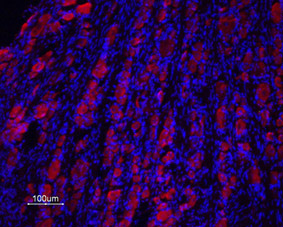Overview
- Peptide (C)DQNGNTSFAPDLN, corresponding to amino acid residues 3-15 of rat PROKR2 (Accession Q8R415). Extracellular, N-terminus.

 Western blot analysis of rat brain membranes:1. Anti-Prokineticin Receptor 2 (extracellular) Antibody (#APR-042), (1:200).
Western blot analysis of rat brain membranes:1. Anti-Prokineticin Receptor 2 (extracellular) Antibody (#APR-042), (1:200).
2. Anti-Prokineticin Receptor 2 (extracellular) Antibody, preincubated with Prokineticin Receptor 2 (extracellular) Blocking Peptide (#BLP-PR042).
 Expression of Prokineticin receptor 2 in rat DRGImmunohistochemical staining of rat dorsal root ganglion (DRG) frozen sections using Anti-Prokineticin Receptor 2 (extracellular) Antibody (#APR-042), (1:100), followed by goat anti-rabbit-AlexaFluor-594 secondary antibody (red). Staining is present in small, medium and large DRG neurons. Hoechst 33342 is used as the counterstain (blue).
Expression of Prokineticin receptor 2 in rat DRGImmunohistochemical staining of rat dorsal root ganglion (DRG) frozen sections using Anti-Prokineticin Receptor 2 (extracellular) Antibody (#APR-042), (1:100), followed by goat anti-rabbit-AlexaFluor-594 secondary antibody (red). Staining is present in small, medium and large DRG neurons. Hoechst 33342 is used as the counterstain (blue).
- Zhou, Q.Y. (2006) Mol. Interv. 6, 330.
- Cheng, M.Y. et al. (2002) Nature 417, 405.
- Pitteloud, N. et al. (2007) Proc. Natl. Acad. Sci. U.S.A. 104, 17447.
The Prokineticins (PK1 and PK2) are a pair of cysteine-rich secreted peptides with broad physiological functions including gastrointestinal motility, angiogenesis, hematopoiesis and circadian rhythms regulation.
The biological effects of PK1 and PK2 are mediated by two highly homologous receptors termed Prokineticin receptor 1 (PKR1) and Prokineticin receptor 2 (PKR2) that belong to the 7-transmembrane domain, G-protein coupled receptor (GPCR) superfamily. Both PK ligands activate the two PK receptors with similar potency.1
PKR2 receptors couple to Gq/G11 proteins leading to phospholipase C activation, inositol phosphate production and calcium mobilization.
The distribution of PKR2 is relatively restricted with high expression levels in the brain, spinal cord and dorsal root ganglions, in organs of the reproductive system and in endocrine tissues such as the thyroid, pituitary and adrenal glands.1
The PK2 ligand has been shown to be involved in the regulation of circadian rhythms of physiological and behavioral processes in mammals, probably through signaling via PKR2 which is highly expressed in the suprachiasmatic nucleus (SCN), an area of the brain that controls circadian rhythm processes.2
In addition, loss-of-function mutations in the PKR2 gene have been associated with Kallmann Syndrome, a condition characterized by idiopathic hypogonadotropic hypogonadism (IHH) in combination with anosmia, a compromised sense of smell.3
Application key:
Species reactivity key:
Alomone Labs is pleased to offer a highly specific antibody directed against an epitope located at the extracellular N-terminal domain of the rat Prokineticin receptor 2. The epitope is specific for PROKR2 and will not cross-react with the closely related PROKR1. Anti-Prokineticin Receptor 2 (extracellular) Antibody (#APR-042) can be used in western blot and immunohistochemical applications. It has been designed to recognize PROKR2 from rat, mouse, and human samples.
Applications
Citations
- Immunohistochemical staining of mouse DRG sections. Tested in PKR2-/- mice.
Maftei, D. et al. (2020) Neuroscience 427, 16.
- Mouse DRG sections. Tested in PKR2-/- mice.
Maftei, D. et al. (2020) Neuroscience 427, 16.

